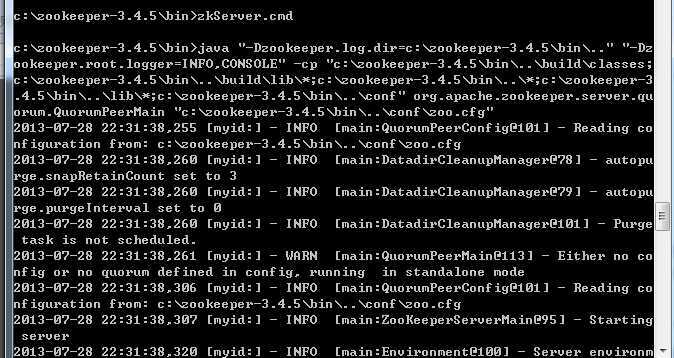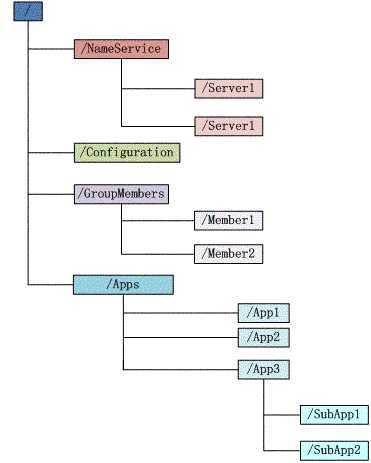Windows安装和使用zookeeper
2020-12-13 02:53
标签:des style class blog code java 本文介绍的 Zookeeper 是以 3.4.5 这个稳定版本为基础,最新的版本可以通过官网 http://hadoop.apache.org/zookeeper/来获取,Zookeeper 的安装非常简单,下面将从单机模式和集群模式两个方面介绍 Zookeeper 的Windows安装和配置. CSDN下载地址:http://download.csdn.net/detail/javadxz/7484051 首先需要安装JdK,从Oracle的Java网站下载,安装很简单,就不再详述。 单机模式 单机安装非常简单,只要获取到 Zookeeper 的压缩包并解压到某个目录如:C:\zookeeper-3.4.5\下,Zookeeper 的启动脚本在 bin 目录下,Windows 下的启动脚本是 bin目录下的zkServer.cmd。 在你执行启动脚本之前,还有几个基本的配置项需要配置一下,Zookeeper 的配置文件在 conf 目录下,这个目录下有 zoo_sample.cfg 和 log4j.properties,你需要做的就是将 zoo_sample.cfg 改名为 zoo.cfg,因为 Zookeeper 在启动时会找这个文件作为默认配置文件。下面详细介绍一下,这个配置文件中各个配置项的意义。 当这些配置项配置好后,你现在就可以启动 Zookeeper 了,启动后要检查 Zookeeper 是否已经在服务,可以通过 netstat – ano 命令查看是否有你配置的 clientPort 端口号在监听服务。 集群模式 Zookeeper 不仅可以单机提供服务,同时也支持多机组成集群来提供服务。实际上 Zookeeper 还支持另外一种伪集群的方式,也就是可以在一台物理机上运行多个 Zookeeper 实例,下面将介绍集群模式的安装和配置。 Zookeeper 的集群模式的安装和配置也不是很复杂,所要做的就是增加几个配置项。集群模式除了上面的三个配置项还要增加下面几个配置项: initLimit=5 数据模型 Zookeeper 会维护一个具有层次关系的数据结构,它非常类似于一个标准的文件系统,如图 1 所示: Zookeeper 这种数据结构有如下这些特点: 如何使用 Zookeeper 作为一个分布式的服务框架,主要用来解决分布式集群中应用系统的一致性问题,它能提供基于类似于文件系统的目录节点树方式的数据存储,但是 Zookeeper 并不是用来专门存储数据的,它的作用主要是用来维护和监控你存储的数据的状态变化。通过监控这些数据状态的变化,从而可以达到基于数据的集群管理. 通过C#代码使用zookeeper Zookeeper的使用主要是通过创建其Nuget ZooKeeperNet包下的Zookeeper实例,并且调用其接口方法进行的,主要的操作就是对znode的增删改操作,监听znode的变化以及处理。 浅析 创建连接: 1.获取服务主机列表 2.设置超时时间 3.注册客户端事件 4.以线程安全的方式创建请求连接(启动客户端请求队列,循环队列基于socket通信、根据请求类型执行不同的请求动作) 请求流程: 构造请求头、构造request,reponse、构造响应头、构造Packet对象,packet对象准备好后,把整个对象放入一个outgoingQueue 响应流程: 针对心跳的ping请求的resp,针对auth请求的resp,一般接口请求的resp,如果接口请求要求了watcher,当watcher关注的内容有变化时的notification 锁相关部分API方法: 创建节点:create demo:zk.Create(Dir, severname.GetBytes(), Ids.OPEN_ACL_UNSAFE, CreateMode.Persistent); 其中CreateMode分为4类Persistent、PersistentSequential、Ephemeral、EphemeralSequential PERSISTENT 创建持久化节点,对应机器关闭连接后节点/数据不会消失 PERSISTENT_SEQUENTIAL 如果PATH是以’/’结尾则以这个PATH作为父节点,创建一个子节点,其子节点名字是一个按先后顺序排列的数值;否则创建一个名字是‘/’后面字符加上先后顺序排列的数值字符串的节点,同样创建持久节点 EPHEMERAL 创建瞬时节点,Zookeeper在感知连接机器宕机后会清除它创建的瞬时节点 EPHEMERAL_SEQUENTIAL 穿件瞬时顺序节点,和PERSISTENT_SEQUENTIAL一样,区别在于它是瞬时的 删除节点 delete demo :zk.Delete(Dir, -1); 前一个参数代表节点名称(一般用作路径),后一个是版本号 -1表示全匹配 查看节点 exists demo : zk.Exists(Dir, new MyWatch2()); 获取数据 getData demo :zk.GetData(Dir, new MyWatch2(), stat); 获取一个节点的数据,可注入watcher 设置数据 setData demo : zk.SetData(Dir, new byte[1], 1); 获取下级节点集合 GetChildren demo :zk.GetChildren(Dir, true); 存储 znodes类似文件和目录。但它不是一个典型的文件系统,zookeeper数据保存在内存中,这意味着zookeeper可以实现高吞吐量和低延迟。 watcher Zookeeper有两种watches,一种是data watches,另一种是child watches。其中,getData()和exists()以及create()等会添加data watches,getChildren()会添加child watches。而delete()涉及到删除数据和子节点,会同时触发data watches和child watches。 示例代码下载:ZookeeperDemo.zip Windows安装和使用zookeeper,搜素材,soscw.com Windows安装和使用zookeeper 标签:des style class blog code java 原文地址:http://www.cnblogs.com/duanxz/p/3782423.html# The number of milliseconds of each tick
tickTime=2000
# The number of ticks that the initial
# synchronization phase can take
initLimit=10
# The number of ticks that can pass between
# sending a request and getting an acknowledgement
syncLimit=5
# the directory where the snapshot is stored.
# do not use /tmp for storage, /tmp here is just
# example sakes.
dataDir=C:\\zookeeper-3.4.5\\data
dataLogDir=C:\\zookeeper-3.4.5\\log
# the port at which the clients will connect
clientPort=2181
#
# Be sure to read the maintenance section of the
# administrator guide before turning on autopurge.
#
# http://zookeeper.apache.org/doc/current/zookeeperAdmin.html#sc_maintenance
#
# The number of snapshots to retain in dataDir
#autopurge.snapRetainCount=3
# Purge task interval in hours
# Set to "0" to disable auto purge feature
#autopurge.purgeInterval=1

syncLimit=2
server.1=192.168.211.1:2888:3888
server.2=192.168.211.2:2888:3888

using System;
using System.Collections.Generic;
using System.Linq;
using System.Text;
using ZooKeeperNet;
namespace ZookeeperDemo
{
class Watcher : IWatcher
{
public void Process(WatchedEvent @event)
{
if (@event.Type == EventType.NodeDataChanged)
{
Console.WriteLine(@event.Path);
}
}
}
}
using System;
using System.Collections.Generic;
using System.Linq;
using System.Text;
using ZooKeeperNet;
namespace ZookeeperDemo
{
class Program
{
static void Main(string[] args)
{
//创建一个Zookeeper实例,第一个参数为目标服务器地址和端口,第二个参数为Session超时时间,第三个为节点变化时的回调方法
using (ZooKeeper zk = new ZooKeeper("127.0.0.1:2181", new TimeSpan(0, 0, 0, 50000), new Watcher()))
{
var stat = zk.Exists("/root",true);
////创建一个节点root,数据是mydata,不进行ACL权限控制,节点为永久性的(即客户端shutdown了也不会消失)
//zk.Create("/root", "mydata".GetBytes(), Ids.OPEN_ACL_UNSAFE, CreateMode.Persistent);
//在root下面创建一个childone znode,数据为childone,不进行ACL权限控制,节点为永久性的
zk.Create("/root/childone", "childone".GetBytes(), Ids.OPEN_ACL_UNSAFE, CreateMode.Persistent);
//取得/root节点下的子节点名称,返回List
packet被放入outgoingQueue中,等待SendThread把packet对应的内容发送给server。server处理分3步在doio方法中ReadLength ReadConnectResult ReadResponse,直到ReadResponse方法中确定packet请求结束。